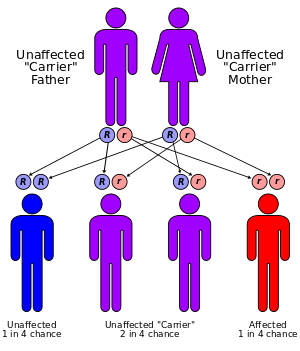Arterial tortuosity syndrome
| Arterial tortuosity syndrome (ATS) | |
|---|---|
| Classification and external resources | |
| OMIM | 208050 |
Arterial tortuosity syndrome (ATS) is a rare congenital connective tissue condition disorder characterized by elongation and generalized tortuosity of the major arteries including the aorta. It is associated with hyperextensible skin and hypermobility of joints, however symptoms vary depending on the patient. Because ATS is so rare, not much is known about the disease.
It exhibits autosomal recessive inheritance, and the responsible gene is located at chromosome 20q13.[1]
It is associated with GLUT10 (also known as SLC2A10)[2] and TGFBR2.[3]

Arterial tortuosity syndrome has an autosomal recessive pattern of inheritance.
References
- ↑ Coucke PJ, Wessels MW, Van Acker P; et al. (2003). "Homozygosity mapping of a gene for arterial tortuosity syndrome to chromosome 20q13". J. Med. Genet. 40 (10): 747–751. doi:10.1136/jmg.40.10.747. PMC 1735278. PMID 14569121.
- ↑ Faiyaz-Ul-Haque M, Zaidi SH, Wahab AA; et al. (August 2008). "Identification of a p.Ser81Arg encoding mutation in SLC2A10 gene of arterial tortuosity syndrome patients from 10 Qatari families". Clin. Genet. 74 (2): 189–93. doi:10.1111/j.1399-0004.2008.01049.x. PMID 18565096.
- ↑ Schievink, W. I.; Gordon, O. K.; Hyland, J. C.; Ala-Kokko, L. (2008). "Absence of TGFBR2 mutations in patients with spontaneous spinal CSF leaks and intracranial hypotension". The Journal of Headache and Pain 9 (2): 99–102. doi:10.1007/s10194-008-0017-y. PMC 3476180. PMID 18264665.
| ||||||||||||||||||
This article is issued from Wikipedia - version of the Sunday, August 16, 2015. The text is available under the Creative Commons Attribution/Share Alike but additional terms may apply for the media files.